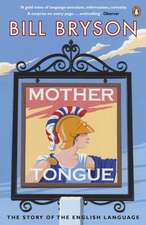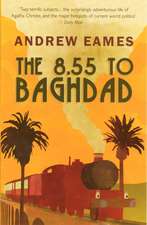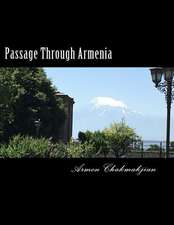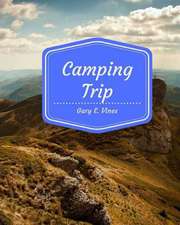Bill Bryson's African Diary
Autor Bill Brysonen Limba Engleză Hardback – 30 noi 2002
Bill Bryson travels to Kenya in support of CARE International. All royalties and profits go to CARE International.
Bryson visits Kenya at the invitation of CARE International, the charity dedicated to eradicating poverty. Kenya is a land of contrasts, with famous game reserves and a vibrant culture. It also provides plenty to worry a traveller like Bill Bryson, fixated as he is on the dangers posed by snakes, insects and large predators. It is also a country with many serious problems: refugees, AIDS, drought, and grinding poverty. The resultant diary, though short in length, contains the trademark Bryson stamp of wry observation and curious insight.
| Toate formatele și edițiile | Preț | Express |
|---|---|---|
| Hardback (2) | 67.36 lei 24-30 zile | +21.84 lei 5-11 zile |
| Transworld Publishers Ltd – 19 mai 2016 | 67.36 lei 24-30 zile | +21.84 lei 5-11 zile |
| BROADWAY BOOKS – 30 noi 2002 | 78.14 lei 3-5 săpt. |
Preț: 78.14 lei
Nou
Puncte Express: 117
Preț estimativ în valută:
14.95€ • 15.55$ • 12.35£
14.95€ • 15.55$ • 12.35£
Carte disponibilă
Livrare economică 24 martie-07 aprilie
Preluare comenzi: 021 569.72.76
Specificații
ISBN-13: 9780767915069
ISBN-10: 0767915062
Pagini: 64
Ilustrații: 1-8 PAGE INSERT
Dimensiuni: 135 x 186 x 12 mm
Greutate: 0.15 kg
Ediția:Broadway Bks Hd.
Editura: BROADWAY BOOKS
ISBN-10: 0767915062
Pagini: 64
Ilustrații: 1-8 PAGE INSERT
Dimensiuni: 135 x 186 x 12 mm
Greutate: 0.15 kg
Ediția:Broadway Bks Hd.
Editura: BROADWAY BOOKS
Extras
In the late 1940s and early 1950s after he became a little too saggy to fit into a Tarzan loincloth without depressing popcorn sales among cinema audiences, the great Johnny Weissmuller filled the twilight years of his acting career with a series of low-budget adventure movies with titles like Devil Goddess and Jungle Moon Men, all built around a character called Jungle Jim. These modest epics are largely forgotten now, which is a pity because they were possibly the most cherishably terrible movies ever made.
The plots seldom got anywhere near coherence. My own favorite, called Pygmy Island, involved a lost tribe of white midgets and a strange but valiant fight against the spread of Communism. But the narrative possibilities were practically infinite since each Jungle Jim feature consisted in large measure of scenes taken from other, wholly unrelated adventure movies. Whatever footage was available--train crashes, volcanic eruptions, rhino charges, panic scenes involving large crowds of Japanese--would be snipped from the original and woven into Jungle Jim's wondrously accommodating story lines. From time to time, the ever-more-fleshy Weissmuller would appear on the scene to wrestle the life out of a curiously rigid and unresisting crocodile or chase some cannibals into the woods, but these intrusions were generally brief and seldom entirely explained.
I wouldn't be at all surprised to learn that no more than four people at a time ever paid money to watch a Jungle Jim movie. The series might well have escaped my own attention except that in about 1959 WOI-TV, a television station well known in central Iowa for its tireless commitment to mediocrity, acquired the complete Jungle Jim oeuvre and for the next dozen or so years showed two of them back to back late every Friday night. What is especially tragic about all this is that I not only watched these movies with unaccountable devotion, but was indelibly influenced by them. In fact, were it not for some scattered viewings of the 1952 classic Bwana Devil and a trip on the Jungle Safari ride at Disneyland in 1961, my knowledge of African life, I regret to say, would be entirely dependent on Jungle Jim movies.
I can't say it actively preyed on me that my impressions of Africa were based so heavily on a series of B-movies made in California more than half a century ago, but when a personable young man named Dan McLean from the London office of CARE International, the venerable and worthy charity, asked me if I would be willing to go to Kenya to visit some of their projects and write a few words on their behalf, it occurred to me that there were some gaps in my familiarity with the Dark Continent that I might usefully fill in. So I agreed.
Some weeks later, I was summoned to CARE's London offices for a meeting with Dan, his boss Will Day and a rugged and amiable fellow named Nick Southern, CARE's regional manager for Kenya, who happened to be in London at the time. We sat around a big table spread with maps of Kenya, while they outlined what they had in mind for me.
"Of course, you'll have to fly to the refugee camp at Dadaab," Will observed thoughtfully at one point. He glanced at me. "To avoid the bandits," he explained.
Dan and Nick nodded gravely.
"I beg your pardon?" I said, taking a sudden interest.
"It's bandit country all round there," Will said.
"Where?" I asked, peering at the map for the first time.
"Oh, just there," Will said, waving a hand vaguely across most of east Africa. "But you'll be fine in a plane."
"They only rarely shoot at planes," Nick explained.
This wasn't at all what I had had in mind, frankly. By way of homework, I had dutifully watched Out of Africa, from which I derived the impression that this trip would mostly take place on a verandah somewhere while turbaned servants brought me lots of coffee. I knew that we would probably visit a clinic from time to time and that someone in the party might occasionally have to shoot a charging animal, but I hadn't imagined anything shooting at me in return.
"So how dangerous is Kenya then?" I asked in a small controlled squeak.
"Oh, not at all," they responded in unison.
"Well, hardly," Will added.
"It depends on what you mean by dangerous, of course," said Dan.
"Like bleeding and not getting up again," I suggested. "Being shot and stabbed and so forth," I added.
They assured me that that only very rarely happened, and that it was nearly always one or the other. You had to be very unlucky to be shot and stabbed, they said.
"It's mostly diseases you have to worry about," Nick went on. "Malaria, schistosomiasis, trypanosomiasis."
"Rift Valley fever, blackwater fever, yellow fever," said Dan.
"Dengue fever, bilharzia--the usual tropical stuff," added Will.
But they pointed out that you can be inoculated against many of those and for the rest most people manage a more or less complete recovery, given time and a considered programme of physiotherapy. Many even walk again. I asked if there was anything else I should know.
"Well, the roads are a little dangerous--there are some crazy drivers out there," Will said, chuckling.
"But apart from that and the diseases and the bandits and the railway from Nairobi to Mombasa, there's absolutely nothing to worry about," Nick added.
"What's wrong with the railway?"
"Oh, nothing really. It's just the rolling stock is a little antiquated and sometimes the brakes give out coming down out of the mountains--but, hey, if you worried about all the things that might happen you wouldn't go anywhere, would you?"
"I don't go anywhere," I pointed out.
They nodded thoughtfully.
"Well, it'll be an adventure," Will said brightly. "You'll be fine, absolutely fine. Just check your insurance before you go."
And so it was that I became irrevocably committed to the African adventure which follows.
Saturday, September 28
We meet at the Kenya Airways check-in desk at Heathrow, the five brave souls who are to form our party from London. In addition to me and Dan, they are: David Sanderson, a thoughtful and kindly fellow who is soon to take up a post in Johannesburg as CARE's regional manager in South Africa, but joining us now in his capacity as urban specialist; Justin Linnane, an intent but amiable young maker of television documentaries who has volunteered to make a video record of the expedition; and the photographer Jenny Matthews, whose brilliant and compassionate snaps grace this volume. White-haired and sweetly unobtrusive, Jenny is easily the wonder of the lot. If you saw her in a supermarket you would take her for a schoolteacher or civil servant. In fact, for 25 years she has gone wherever there is danger--to Chechnya, Bosnia, Afghanistan, Rwanda. She is fearless and evidently indestructible. If things go bad on this trip, it is her I'll hold on to.
The first good news is that Kenya Airways has given us all an upgrade on account of our genial goodness and dapper manner, and so of course gets a glowing mention here. It is a nine-and-a-half-hour flight from London to Nairobi, and we are very pleased to pass it in comfort, with a better class of drinks and our own party packs.
An hour or so after we are airborne, by chance I come across an article in The Economist declaring Nairobi to be the new crime capital of Africa. My attention is particularly arrested by the disclosure that street children come up to cars waiting at traffic lights demanding money and if it's not given they rub balls of human excrement in the victim's face.
I share this information with my new companions and we agree that Dan, as group leader, will be our designated "rubbee" for the week. Conveniently, Dan is in the lavatory when the matter is discussed and so the motion carries unanimously. In order not to spoil his enjoyment of Nairobi we decide not to tell him of our decision until we see children advancing.
It is nighttime when we land at Jomo Kenyatta Airport and pleasantly cool. We are met by Kentice Tikolo, an immensely good-natured Kenyan lady who helps run CARE's Nairobi office and who shepherds us into waiting cabs. In Out of Africa, Nairobi was depicted as a sunny little country town, so I am disappointed to find that at some time in the past 50 or 60 years they took away that pretty scene and replaced it with Omaha, of all things. Nairobi is merely yet another modern city with traffic lights and big buildings and hoardings advertising Samsung televisions and the like. Our hotel is a Holiday Inn--very nice and comfortable, but hardly a place that shouts: "Welcome to Africa, Bwana."
"Oh, you will see plenty of Africa," Kentice assures me when we convene at the bar for a round of medicinal hydration. "We're going to show you lots of exotic things. Have you ever eaten camel?"
"Only in my junior high school cafeteria, and they called it lamb," I reply. I take the opportunity, while Dan is at the bar, to ask her about the street children I read about on the flight.
"Oh, that's the least of your worries," Kentice laughs. "Car-jackings are much worse. They can be quite violent."
"What a comfort to know."
"But don't worry," she says, laying a comforting hand on my arm and becoming solemn, "if anything goes wrong we have excellent hospitals in Nairobi."
We retire early because we have an early start in the morning. I am disappointed to find that there is no mosquito net around the bed in my room. Unaware that Nairobi is malaria-free, I slather myself with insect repellant and pass a long night sounding like two strips of parting Velcro each time I roll over in the bed and dreaming terrible dreams in which Jungle Jim, assisted by a tribe of white pygmies, chases me through the streets of Omaha with dung balls.
Sunday, September 29
In the morning we drive to Kibera, a sea of tin roofs filling a mile or so of steamy hillside on the south side of the city. Kibera is the biggest slum in Nairobi, possibly the biggest in Africa. Nobody knows how many people live there. It's at least 700,000, but it may be as many as a million, perhaps more. At least 50,000 of Kibera's children are AIDS orphans. At least a fifth of the residents are HIV positive, but it could be as high as 50 percent. Nobody knows. Nothing about Kibera is certain and official, including its existence. It appears on no maps. It just is.
You can't just go in to Kibera if you are an outsider. Well, you can, but you wouldn't come out again. Kibera is a dangerous place. We were taken on a walking tour by the district chief, an amiable giant named Nashon Opiyo, and three of his deputies, all Kibera residents. They are employed by the government to keep an eye--and occasionally a lid--on things, even though Kibera doesn't officially exist.
To step into Kibera is to be lost at once in a random, seemingly endless warren of rank, narrow passageways wandering between rows of frail, dirt-floored hovels made of tin and mud and twigs and holes. Each shanty on average is ten feet by ten and home to five or six people. Down the centre of each lane runs a shallow trench filled with a trickle of water and things you don't want to see or step in. There are no services in Kibera--no running water, no rubbish collection, virtually no electricity, not a single flush toilet. In one section of Kibera called Laini Saba until recently there were just ten pit latrines for 40,000 people. Especially at night when it is unsafe to venture out, many residents rely on what are known as "flying toilets," which is to say they go into a plastic bag, then open their door and throw it as far as possible.
In the rainy season, the whole becomes a liquid ooze. In the dry season it has the charm and healthfulness of a rubbish tip. In all seasons it smells of rot. It's a little like wandering through a privy. Whatever is the most awful place you have ever experienced, Kibera is worse.
Kibera is only one of about a hundred slums in Nairobi, and it is by no means the worst. Altogether more than half of Nairobi's three million people are packed into these immensely squalid zones, which together occupy only about 1.5 percent of the city's land. In wonder I asked David Sanderson what made Kibera superior.
"There are a lot of factories around here," he said, "so there's work, though nearly all of it is casual. If you're lucky you might make a dollar a day, enough to buy a little food and a jerry can of water and to put something aside for your rent."
"How much is rent?"
"Oh, not much. Ten or twelve dollars a month. But the average annual income in Kenya is $280, so $120 or $140 in rent every year is a big slice of your income. And nearly everything else is expensive here, too, even water. The average person in a slum like Kibera pays five times what people in the developed world pay for the same volume of water piped to their homes."
"That's amazing," I said.
He nodded. "Every time you flush a toilet you use more water than the average person in the developing world has for all purposes in a day--cooking, cleaning, drinking, everything. It's very tough. For a lot of people Kibera is essentially a life sentence. Unless you are exceptionally lucky with employment, it's very, very difficult to get ahead."
Every day around the world, 180,000 people fetch up in or are born into cities like Nairobi, mostly into slums like Kibera. Ninety percent of the world's population growth in the twenty-first century will be in cities. "For better or worse, this is where the future is," David said. Yet, amazingly, aid agencies like CARE can do little for urban slums like Kibera. The governments won't let them. "Mostly they won't permit any kind of permanent improvements because they fear it would just affirm Kibera's existence, and also they are afraid that it would encourage more people to pour in from the countryside. So they'd rather pretend these places don't exist."
"But they must know it's here."
He smiled and pointed to a big house--a compound--commanding a neighboring hillside only a couple of hundred yards from Kibera's edge. The house, David told me, was the Nairobi residence of Daniel arap Moi, president of Kenya since 1978. "This is what he sees every morning when he looks out his window. Of course they know it's here."
The plots seldom got anywhere near coherence. My own favorite, called Pygmy Island, involved a lost tribe of white midgets and a strange but valiant fight against the spread of Communism. But the narrative possibilities were practically infinite since each Jungle Jim feature consisted in large measure of scenes taken from other, wholly unrelated adventure movies. Whatever footage was available--train crashes, volcanic eruptions, rhino charges, panic scenes involving large crowds of Japanese--would be snipped from the original and woven into Jungle Jim's wondrously accommodating story lines. From time to time, the ever-more-fleshy Weissmuller would appear on the scene to wrestle the life out of a curiously rigid and unresisting crocodile or chase some cannibals into the woods, but these intrusions were generally brief and seldom entirely explained.
I wouldn't be at all surprised to learn that no more than four people at a time ever paid money to watch a Jungle Jim movie. The series might well have escaped my own attention except that in about 1959 WOI-TV, a television station well known in central Iowa for its tireless commitment to mediocrity, acquired the complete Jungle Jim oeuvre and for the next dozen or so years showed two of them back to back late every Friday night. What is especially tragic about all this is that I not only watched these movies with unaccountable devotion, but was indelibly influenced by them. In fact, were it not for some scattered viewings of the 1952 classic Bwana Devil and a trip on the Jungle Safari ride at Disneyland in 1961, my knowledge of African life, I regret to say, would be entirely dependent on Jungle Jim movies.
I can't say it actively preyed on me that my impressions of Africa were based so heavily on a series of B-movies made in California more than half a century ago, but when a personable young man named Dan McLean from the London office of CARE International, the venerable and worthy charity, asked me if I would be willing to go to Kenya to visit some of their projects and write a few words on their behalf, it occurred to me that there were some gaps in my familiarity with the Dark Continent that I might usefully fill in. So I agreed.
Some weeks later, I was summoned to CARE's London offices for a meeting with Dan, his boss Will Day and a rugged and amiable fellow named Nick Southern, CARE's regional manager for Kenya, who happened to be in London at the time. We sat around a big table spread with maps of Kenya, while they outlined what they had in mind for me.
"Of course, you'll have to fly to the refugee camp at Dadaab," Will observed thoughtfully at one point. He glanced at me. "To avoid the bandits," he explained.
Dan and Nick nodded gravely.
"I beg your pardon?" I said, taking a sudden interest.
"It's bandit country all round there," Will said.
"Where?" I asked, peering at the map for the first time.
"Oh, just there," Will said, waving a hand vaguely across most of east Africa. "But you'll be fine in a plane."
"They only rarely shoot at planes," Nick explained.
This wasn't at all what I had had in mind, frankly. By way of homework, I had dutifully watched Out of Africa, from which I derived the impression that this trip would mostly take place on a verandah somewhere while turbaned servants brought me lots of coffee. I knew that we would probably visit a clinic from time to time and that someone in the party might occasionally have to shoot a charging animal, but I hadn't imagined anything shooting at me in return.
"So how dangerous is Kenya then?" I asked in a small controlled squeak.
"Oh, not at all," they responded in unison.
"Well, hardly," Will added.
"It depends on what you mean by dangerous, of course," said Dan.
"Like bleeding and not getting up again," I suggested. "Being shot and stabbed and so forth," I added.
They assured me that that only very rarely happened, and that it was nearly always one or the other. You had to be very unlucky to be shot and stabbed, they said.
"It's mostly diseases you have to worry about," Nick went on. "Malaria, schistosomiasis, trypanosomiasis."
"Rift Valley fever, blackwater fever, yellow fever," said Dan.
"Dengue fever, bilharzia--the usual tropical stuff," added Will.
But they pointed out that you can be inoculated against many of those and for the rest most people manage a more or less complete recovery, given time and a considered programme of physiotherapy. Many even walk again. I asked if there was anything else I should know.
"Well, the roads are a little dangerous--there are some crazy drivers out there," Will said, chuckling.
"But apart from that and the diseases and the bandits and the railway from Nairobi to Mombasa, there's absolutely nothing to worry about," Nick added.
"What's wrong with the railway?"
"Oh, nothing really. It's just the rolling stock is a little antiquated and sometimes the brakes give out coming down out of the mountains--but, hey, if you worried about all the things that might happen you wouldn't go anywhere, would you?"
"I don't go anywhere," I pointed out.
They nodded thoughtfully.
"Well, it'll be an adventure," Will said brightly. "You'll be fine, absolutely fine. Just check your insurance before you go."
And so it was that I became irrevocably committed to the African adventure which follows.
Saturday, September 28
We meet at the Kenya Airways check-in desk at Heathrow, the five brave souls who are to form our party from London. In addition to me and Dan, they are: David Sanderson, a thoughtful and kindly fellow who is soon to take up a post in Johannesburg as CARE's regional manager in South Africa, but joining us now in his capacity as urban specialist; Justin Linnane, an intent but amiable young maker of television documentaries who has volunteered to make a video record of the expedition; and the photographer Jenny Matthews, whose brilliant and compassionate snaps grace this volume. White-haired and sweetly unobtrusive, Jenny is easily the wonder of the lot. If you saw her in a supermarket you would take her for a schoolteacher or civil servant. In fact, for 25 years she has gone wherever there is danger--to Chechnya, Bosnia, Afghanistan, Rwanda. She is fearless and evidently indestructible. If things go bad on this trip, it is her I'll hold on to.
The first good news is that Kenya Airways has given us all an upgrade on account of our genial goodness and dapper manner, and so of course gets a glowing mention here. It is a nine-and-a-half-hour flight from London to Nairobi, and we are very pleased to pass it in comfort, with a better class of drinks and our own party packs.
An hour or so after we are airborne, by chance I come across an article in The Economist declaring Nairobi to be the new crime capital of Africa. My attention is particularly arrested by the disclosure that street children come up to cars waiting at traffic lights demanding money and if it's not given they rub balls of human excrement in the victim's face.
I share this information with my new companions and we agree that Dan, as group leader, will be our designated "rubbee" for the week. Conveniently, Dan is in the lavatory when the matter is discussed and so the motion carries unanimously. In order not to spoil his enjoyment of Nairobi we decide not to tell him of our decision until we see children advancing.
It is nighttime when we land at Jomo Kenyatta Airport and pleasantly cool. We are met by Kentice Tikolo, an immensely good-natured Kenyan lady who helps run CARE's Nairobi office and who shepherds us into waiting cabs. In Out of Africa, Nairobi was depicted as a sunny little country town, so I am disappointed to find that at some time in the past 50 or 60 years they took away that pretty scene and replaced it with Omaha, of all things. Nairobi is merely yet another modern city with traffic lights and big buildings and hoardings advertising Samsung televisions and the like. Our hotel is a Holiday Inn--very nice and comfortable, but hardly a place that shouts: "Welcome to Africa, Bwana."
"Oh, you will see plenty of Africa," Kentice assures me when we convene at the bar for a round of medicinal hydration. "We're going to show you lots of exotic things. Have you ever eaten camel?"
"Only in my junior high school cafeteria, and they called it lamb," I reply. I take the opportunity, while Dan is at the bar, to ask her about the street children I read about on the flight.
"Oh, that's the least of your worries," Kentice laughs. "Car-jackings are much worse. They can be quite violent."
"What a comfort to know."
"But don't worry," she says, laying a comforting hand on my arm and becoming solemn, "if anything goes wrong we have excellent hospitals in Nairobi."
We retire early because we have an early start in the morning. I am disappointed to find that there is no mosquito net around the bed in my room. Unaware that Nairobi is malaria-free, I slather myself with insect repellant and pass a long night sounding like two strips of parting Velcro each time I roll over in the bed and dreaming terrible dreams in which Jungle Jim, assisted by a tribe of white pygmies, chases me through the streets of Omaha with dung balls.
Sunday, September 29
In the morning we drive to Kibera, a sea of tin roofs filling a mile or so of steamy hillside on the south side of the city. Kibera is the biggest slum in Nairobi, possibly the biggest in Africa. Nobody knows how many people live there. It's at least 700,000, but it may be as many as a million, perhaps more. At least 50,000 of Kibera's children are AIDS orphans. At least a fifth of the residents are HIV positive, but it could be as high as 50 percent. Nobody knows. Nothing about Kibera is certain and official, including its existence. It appears on no maps. It just is.
You can't just go in to Kibera if you are an outsider. Well, you can, but you wouldn't come out again. Kibera is a dangerous place. We were taken on a walking tour by the district chief, an amiable giant named Nashon Opiyo, and three of his deputies, all Kibera residents. They are employed by the government to keep an eye--and occasionally a lid--on things, even though Kibera doesn't officially exist.
To step into Kibera is to be lost at once in a random, seemingly endless warren of rank, narrow passageways wandering between rows of frail, dirt-floored hovels made of tin and mud and twigs and holes. Each shanty on average is ten feet by ten and home to five or six people. Down the centre of each lane runs a shallow trench filled with a trickle of water and things you don't want to see or step in. There are no services in Kibera--no running water, no rubbish collection, virtually no electricity, not a single flush toilet. In one section of Kibera called Laini Saba until recently there were just ten pit latrines for 40,000 people. Especially at night when it is unsafe to venture out, many residents rely on what are known as "flying toilets," which is to say they go into a plastic bag, then open their door and throw it as far as possible.
In the rainy season, the whole becomes a liquid ooze. In the dry season it has the charm and healthfulness of a rubbish tip. In all seasons it smells of rot. It's a little like wandering through a privy. Whatever is the most awful place you have ever experienced, Kibera is worse.
Kibera is only one of about a hundred slums in Nairobi, and it is by no means the worst. Altogether more than half of Nairobi's three million people are packed into these immensely squalid zones, which together occupy only about 1.5 percent of the city's land. In wonder I asked David Sanderson what made Kibera superior.
"There are a lot of factories around here," he said, "so there's work, though nearly all of it is casual. If you're lucky you might make a dollar a day, enough to buy a little food and a jerry can of water and to put something aside for your rent."
"How much is rent?"
"Oh, not much. Ten or twelve dollars a month. But the average annual income in Kenya is $280, so $120 or $140 in rent every year is a big slice of your income. And nearly everything else is expensive here, too, even water. The average person in a slum like Kibera pays five times what people in the developed world pay for the same volume of water piped to their homes."
"That's amazing," I said.
He nodded. "Every time you flush a toilet you use more water than the average person in the developing world has for all purposes in a day--cooking, cleaning, drinking, everything. It's very tough. For a lot of people Kibera is essentially a life sentence. Unless you are exceptionally lucky with employment, it's very, very difficult to get ahead."
Every day around the world, 180,000 people fetch up in or are born into cities like Nairobi, mostly into slums like Kibera. Ninety percent of the world's population growth in the twenty-first century will be in cities. "For better or worse, this is where the future is," David said. Yet, amazingly, aid agencies like CARE can do little for urban slums like Kibera. The governments won't let them. "Mostly they won't permit any kind of permanent improvements because they fear it would just affirm Kibera's existence, and also they are afraid that it would encourage more people to pour in from the countryside. So they'd rather pretend these places don't exist."
"But they must know it's here."
He smiled and pointed to a big house--a compound--commanding a neighboring hillside only a couple of hundred yards from Kibera's edge. The house, David told me, was the Nairobi residence of Daniel arap Moi, president of Kenya since 1978. "This is what he sees every morning when he looks out his window. Of course they know it's here."
Recenzii
“Bryson is one of the funniest travel writers in the business.” -- The Globe and Mail
“Bryson has become an enormously popular travel writer by coming off as the most literate tour guide you’ve ever had.” -- The New York Times
“Bryson is a terrific stylist. You can’t help but enjoy his writing, for its cheer and buoyancy, and for the frequent demonstration of his peculiar, engaging turn of mind.” -- Ottawa Citizen
“Bryson is first and foremost a storyteller -- and a supremely comic and original one at that.” -- Winnipeg Free Press
“Bryson has become an enormously popular travel writer by coming off as the most literate tour guide you’ve ever had.” -- The New York Times
“Bryson is a terrific stylist. You can’t help but enjoy his writing, for its cheer and buoyancy, and for the frequent demonstration of his peculiar, engaging turn of mind.” -- Ottawa Citizen
“Bryson is first and foremost a storyteller -- and a supremely comic and original one at that.” -- Winnipeg Free Press
Notă biografică
BILL BRYSON'S Bestselling books include A Walk in the Woods, I’m a Stranger Here Myself, In A Sunburned Country, Bryson’s Dictionary of Troublesome Words, Bill Bryson's African Diary, and A Short History of Nearly Everything. He lives in Norfolk, England, with his wife and children.
From the Trade Paperback edition.
From the Trade Paperback edition.
Descriere
Invited by CARE International, the author of "In a Sunburned Country" now visits Kenya and observes the many contrasts of Kenyan life, from the country's dramatic geography and famous game reserves to its postcolonial poverty and environmental problems. The author's earnings from this diary, as well as a portion of the profits, go to CARE. of color photos.






















